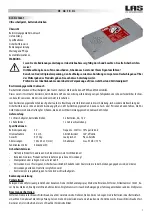
Inter-integrated circuit (I
2
C) interface
RM0090
846/1731
DocID018909 Rev 11
For the details on 128 bit UDID and more information on ARP, refer to SMBus specification
version 2.0 (
http://smbus.org/
).
SMBus alert mode
SMBus Alert is an optional signal with an interrupt line for devices that want to trade their
ability to master for a pin. SMBA is a wired-AND signal just as the SCL and SDA signals are.
SMBA is used in conjunction with the SMBus General Call Address. Messages invoked with
the SMBus are 2 bytes long.
A slave-only device can signal the host through SMBA that it wants to talk by setting ALERT
bit in I2C_CR1 register. The host processes the interrupt and simultaneously accesses all
SMBA devices through the
Alert Response Address
(known as ARA having a value 0001
100X). Only the device(s) which pulled SMBA low will acknowledge the Alert Response
Address. This status is identified using SMBALERT Status flag in I2C_SR1 register. The
host performs a modified Receive Byte operation. The 7 bit device address provided by the
slave transmit device is placed in the 7 most significant bits of the byte. The eighth bit can
be a zero or one.
If more than one device pulls SMBA low, the highest priority (lowest address) device will win
communication rights via standard arbitration during the slave address transfer. After
acknowledging the slave address the device must disengage its SMBA pull-down. If the
host still sees SMBA low when the message transfer is complete, it knows to read the ARA
again.
A host which does not implement the SMBA signal may periodically access the ARA.
For more details on SMBus Alert mode, refer to SMBus specification version 2.0
(
http://smbus.org/
).
Timeout error
There are differences in the timing specifications between I
2
C and SMBus.
SMBus defines a clock low timeout, TIMEOUT of 35 ms. Also SMBus specifies TLOW:
SEXT as the cumulative clock low extend time for a slave device. SMBus specifies TLOW:
MEXT as the cumulative clock low extend time for a master device. For more details on
these timeouts, refer to SMBus specification version 2.0 (
http://smbus.org/
).
The status flag Timeout or Tlow Error in I2C_SR1 shows the status of this feature.
How to use the interface in SMBus mode
To switch from I
2
C mode to SMBus mode, the following sequence should be performed.
•
Set the SMBus bit in the I2C_CR1 register
•
Configure the SMBTYPE and ENARP bits in the I2C_CR1 register as required for the
application
If you want to configure the device as a master, follow the Start condition generation
procedure in
Section 27.3.3: I2C master mode
. Otherwise, follow the sequence in
Section 27.3.2: I2C slave mode
.
The application has to control the various SMBus protocols by software.
•
SMB Device Default Address acknowledged if ENARP=1 and SMBTYPE=0
•
SMB Host Header acknowledged if ENARP=1 and SMBTYPE=1
•
SMB Alert Response Address acknowledged if SMBALERT=1
















































